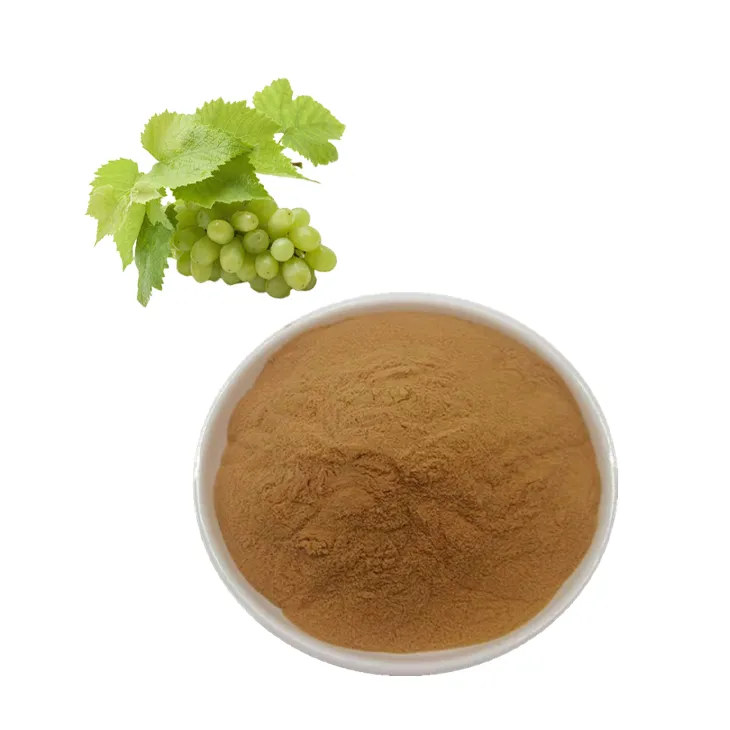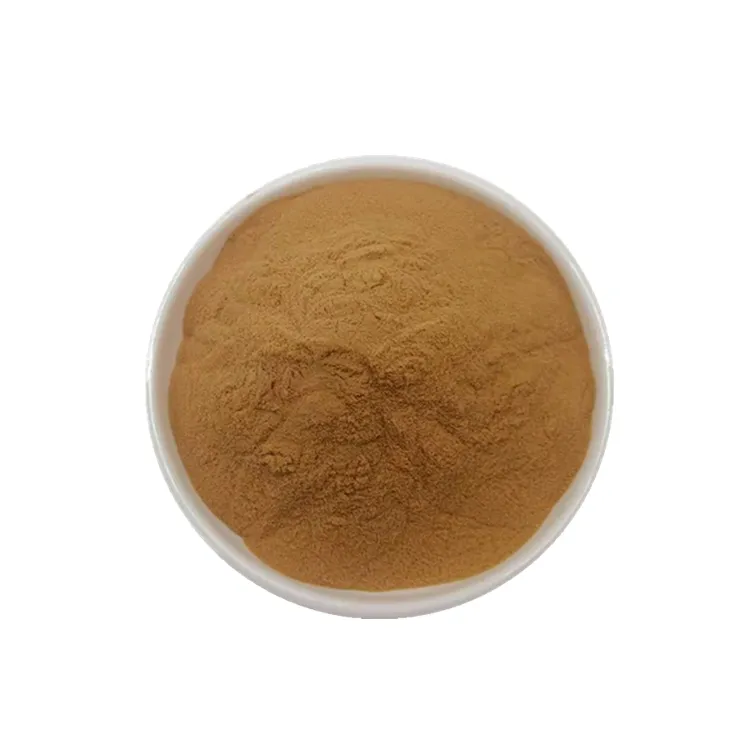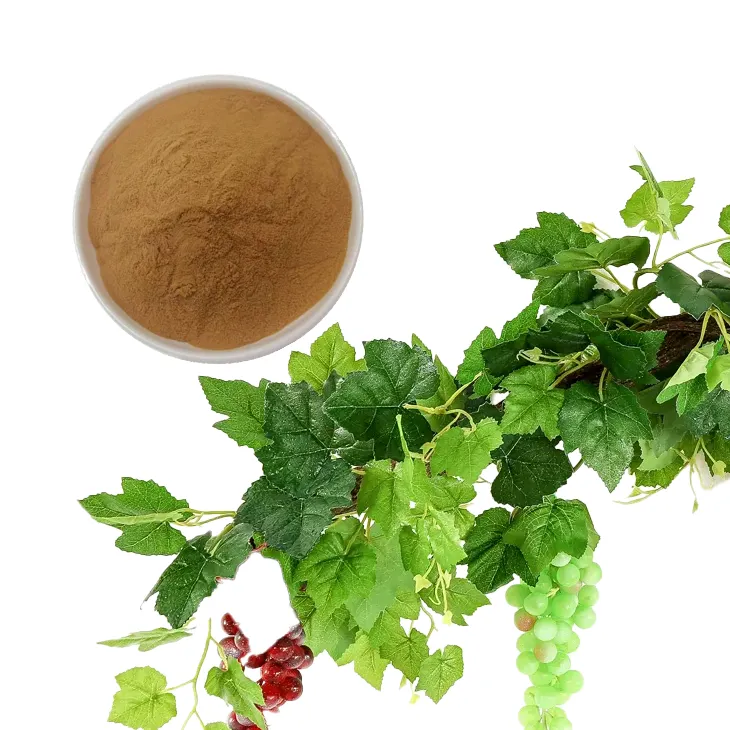- 0086-571-85302990
- sales@greenskybio.com
Grape Leaf Extract Manufacturers.
2024-11-28

1. Introduction to Grape Leaf Extract
Grape Leaf Extract has been emerging as a significant ingredient in multiple industries in recent years. The extract is rich in various bioactive compounds, which are of great interest for their potential applications in health, beauty, and food sectors. These bioactive components are what make Grape Leaf Extract a valuable commodity, and it all starts with the manufacturing process.

2. The Source of Grape Leaves
The quality of grape leaves is a fundamental factor for grape leaf extract manufacturers. High - quality grape leaves are typically sourced from well - maintained vineyards. These vineyards ensure that the grapes are grown in optimal conditions, which in turn reflects on the quality of the leaves.
- Vineyard management: Vineyards need to be carefully managed in terms of irrigation, pest control, and soil quality. For example, proper irrigation ensures that the grapes and leaves receive the right amount of water, preventing dehydration or over - watering which can affect the chemical composition of the leaves.
- Grape variety: Different grape varieties can have an impact on the characteristics of the leaves and, consequently, the extract. Some grape varieties may have leaves with higher levels of certain bioactive compounds, making them more desirable for extraction.

3. Extraction Techniques
Manufacturers use a variety of extraction techniques to obtain grape leaf extract, each with its own advantages and considerations.
3.1 Solvent Extraction
Solvent extraction is one of the commonly used methods. In this process, solvents such as ethanol are used to draw out the active compounds from the grape leaves.
- How it works: The grape leaves are soaked in the solvent, and over time, the solvent dissolves the bioactive compounds present in the leaves. The mixture is then processed further to separate the solvent from the extract, leaving behind the concentrated grape leaf extract.
- Advantages: It is a relatively straightforward and cost - effective method. Ethanol, as a solvent, is also widely available and has a good ability to dissolve a wide range of bioactive compounds.
- Limitations: However, there are some drawbacks. The use of solvents may leave behind some traces in the final product, although strict quality control measures are in place to minimize this. Also, the extraction process may not be as selective as other methods, potentially resulting in a less pure extract.
3.2 Supercritical Fluid Extraction
Supercritical fluid extraction, often using carbon dioxide as the supercritical fluid, is another extraction method.
- How it works: Carbon dioxide is brought to its supercritical state (a state where it has properties between a gas and a liquid) by adjusting the temperature and pressure. In this state, it can effectively penetrate the grape leaves and extract the bioactive compounds. Once the extraction is complete, the pressure is released, and the carbon dioxide returns to its gaseous state, leaving behind a pure extract.
- Advantages: This method is more environmentally friendly compared to solvent extraction as carbon dioxide is a non - toxic and non - flammable gas. It also offers a higher degree of selectivity, resulting in a purer extract with a more consistent composition of bioactive compounds.
- Limitations: The equipment required for supercritical fluid extraction is more complex and expensive, which can increase the overall cost of production. Additionally, the process requires precise control of temperature and pressure conditions.

4. Quality Control in Manufacturing
Quality control is an absolute necessity for grape leaf extract manufacturers. It ensures that the final product meets the required standards for various applications.
4.1 Contaminant Removal
Removing contaminants is a crucial part of quality control. Grape leaves may be exposed to pesticides, heavy metals, or other pollutants during growth. Manufacturers need to implement strict measures to ensure that these contaminants are not present in the final extract.
- Testing procedures: Regular testing for pesticides and heavy metals is carried out using advanced analytical techniques such as chromatography and spectrometry. For example, high - performance liquid chromatography (HPLC) can be used to detect and quantify the presence of pesticides at very low levels.
- Certifications: Many manufacturers strive to obtain relevant certifications such as organic certifications, which require strict compliance with standards regarding contaminant levels. These certifications not only ensure the quality of the product but also enhance its marketability.
4.2 Composition Consistency
Ensuring consistent composition is another important aspect of quality control. The levels of bioactive compounds in the grape leaf extract should be within a certain range to guarantee its effectiveness.
- Batch - to - batch analysis: Manufacturers conduct regular batch - to - batch analysis to check the consistency of the extract's composition. This involves analyzing the levels of key bioactive compounds such as flavonoids and phenolic acids. If there are significant variations between batches, adjustments need to be made to the extraction process.
- Standard operating procedures: To maintain composition consistency, manufacturers follow strict standard operating procedures (SOPs) during the extraction and processing of grape leaves. These SOPs cover every step of the manufacturing process, from the selection of raw materials to the final packaging of the extract.
5. Research and Development in the Industry
Research and development (R & D) are integral parts of the operations of grape leaf extract manufacturers.
5.1 Improving Extraction Efficiency
Enhancing extraction efficiency is a continuous pursuit in the R & D efforts of manufacturers.
- New extraction technologies: Manufacturers are constantly exploring new extraction technologies that can improve the yield of bioactive compounds from grape leaves. For example, the development of novel solvent systems or the combination of different extraction methods may lead to a more efficient extraction process.
- Process optimization: By studying the physical and chemical properties of grape leaves and the extraction mechanisms, manufacturers can optimize the existing extraction processes. This may involve adjusting parameters such as temperature, pressure, and extraction time to achieve maximum efficiency.
5.2 Enhancing Bioactivity
Boosting the bioactivity of grape leaf extract is another focus of R & D.
- Bioactive compound enhancement: Research is being carried out to find ways to increase the levels of beneficial bioactive compounds in the extract. This could involve genetic modification of grape plants or the development of post - extraction treatments that can enhance the bioactivity of the existing compounds.
- New bioactive compound discovery: In addition to known bioactive compounds like flavonoids and phenolic acids, manufacturers are also looking for new compounds in grape leaves that may have unique health or functional properties. New extraction and analysis techniques are being used to identify and isolate these potential compounds.
5.3 Discovering New Applications
Finding new applications for grape leaf extract is an important area of R & D.
- Cosmetics: Grape leaf extract has potential applications in the cosmetics industry. Its antioxidant properties can be used to develop anti - aging products, such as creams and serums. The extract may also have moisturizing and skin - soothing effects, which are being explored further.
- Food additives: In the food industry, grape leaf extract can be used as a natural food additive. It can act as a preservative due to its antioxidant activity, or it can be added to functional foods to provide additional health benefits. For example, it could be incorporated into beverages or snacks.
- Pharmaceutical applications: The bioactive compounds in grape leaf extract may have potential pharmaceutical applications. Research is ongoing to investigate its role in preventing or treating certain diseases, such as cardiovascular diseases or diabetes.
6. Market and Industry Trends
The market for grape leaf extract is influenced by several trends, which manufacturers need to be aware of to stay competitive.
- Increasing demand for natural products: Consumers are increasingly demanding natural products, which has led to a growing interest in grape leaf extract as a natural source of bioactive compounds. Manufacturers need to position their products accordingly in the market, highlighting the natural origin and benefits of the extract.
- Stringent regulatory requirements: Regulatory requirements for food, nutraceutical, and pharmaceutical products are becoming more stringent. Manufacturers need to ensure that their products comply with these regulations, which may involve additional testing and documentation.
- Sustainable production: There is a growing emphasis on sustainable production methods. Manufacturers are expected to adopt sustainable practices in sourcing grape leaves, such as promoting organic farming and reducing the environmental impact of the extraction process.
7. Conclusion
Grape leaf extract manufacturers play a vital role in the development and supply of this valuable product. Through careful selection of raw materials, advanced extraction techniques, strict quality control, and continuous research and development, they are able to produce high - quality grape leaf extract that has a wide range of applications in various industries. As the market continues to evolve, manufacturers will need to adapt to new trends and challenges to remain successful in this competitive field.
FAQ:
What are the main sources of grape leaves for manufacturers?
Manufacturers typically source grape leaves from well - maintained vineyards. These vineyards ensure that the grape leaves are of high quality, which is the foundation for producing a superior grape leaf extract.
What extraction techniques do grape leaf extract manufacturers use?
They use advanced extraction techniques. For example, solvent extraction which uses solvents like ethanol to draw out active compounds from the grape leaves. Another method is supercritical fluid extraction, often using carbon dioxide, which is more environmentally friendly and can produce a pure extract.
Why is quality control important for grape leaf extract manufacturers?
Quality control is crucial because they need to make sure that the final product is free from contaminants, has a consistent composition, and contains the desired levels of bioactive compounds such as antioxidants (flavonoids and phenolic acids). These properties are important for its potential health benefits and applications in industries like nutraceutical and pharmaceutical.
What is the role of research and development in grape leaf extract manufacturing?
Research and development play key roles. Manufacturers are constantly looking for new ways to improve extraction efficiency, enhance the bioactivity of the extract, and discover new applications in areas like cosmetics and food additives.
What are the potential health benefits of the bioactive compounds in grape leaf extract?
The bioactive compounds such as flavonoids and phenolic acids are antioxidants. Antioxidants can help protect the body from damage caused by free radicals, which may be related to various health benefits, and this makes grape leaf extract potentially useful in the nutraceutical and pharmaceutical industries.
Related literature
- The Bioactivity and Potential Applications of Grape Leaf Extract"
- "Manufacturing Processes of Grape Leaf Extract: A Comprehensive Review"
- "Quality Assurance in Grape Leaf Extract Production"
- ▶ Hesperidin
- ▶ citrus bioflavonoids
- ▶ plant extract
- ▶ lycopene
- ▶ Diosmin
- ▶ Grape seed extract
- ▶ Sea buckthorn Juice Powder
- ▶ Beetroot powder
- ▶ Hops Extract
- ▶ Artichoke Extract
- ▶ Reishi mushroom extract
- ▶ Astaxanthin
- ▶ Green Tea Extract
- ▶ Curcumin Extract
- ▶ Horse Chestnut Extract
- ▶ Other Problems
- ▶ Boswellia Serrata Extract
- ▶ Resveratrol Extract
- ▶ Marigold Extract
- ▶ Grape Leaf Extract
- ▶ blog3
- ▶ blog4
-
D - Mannose Manufacturer
2024-11-28
-
The best organic chia seed powder.
2024-11-28
-
The extraction process of Maca extract.
2024-11-28
-
Organic Motherwort Extract Powder Supplier.
2024-11-28
-
The Pure Vitamin K2 Most Worth Buying.
2024-11-28
-
Chinese Hawthorn Extract Powder Suppliers.
2024-11-28
-
Lemon Balm Extract
2024-11-28
-
Kidney Bean Extract
2024-11-28
-
Lily extract
2024-11-28
-
Red Wine Extract
2024-11-28
-
Natural grape seed extract
2024-11-28
-
melatonin extract
2024-11-28
-
Elderberry Extract
2024-11-28
-
Curcuma Longa Extract/Turmeric extract
2024-11-28
-
Rosemary extract
2024-11-28
-
Plantain extract
2024-11-28





















